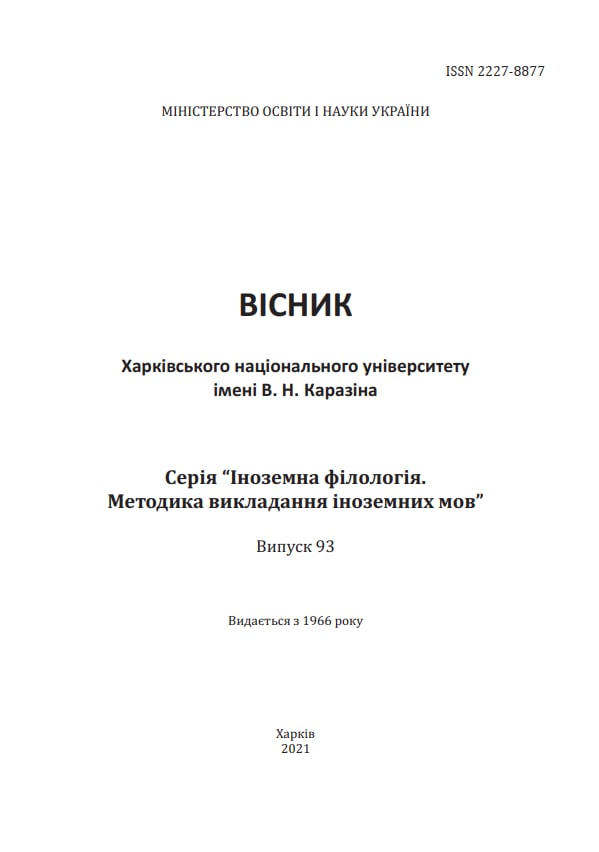Використання ЗМІ у рамках когнітивно-комунікативного підходу до викладання іноземної мови
Анотація
Статтю присвячено вивченню елементів формування комунікативної компетенції студентів з урахуванням когнітивного аспекту навчання іноземної мови. Даний підхід дає змогу на раціональне оволодіння лексико-граматичним матеріалом, водночас забезпечує поширення загальних знань картини світу, притаманної носіям мови, що вивчається. Метою дослідження є аналіз ефективності використання аутентичного допоміжного матеріалу під час викладання іноземної мови задля оптимізації навчального процесу. З огляду на функції, представлені засобами масової інформації (ЗМІ), робота з публіцистичними та аудіовізуальними матеріалами даного типу є одної з провідних у рамках когнітивно-комунікативного підходу до вивчення іноземної мови. У статті надається детальний аналіз етапів роботи з засобами масової інформації та роз’яснюються елементи продуктивності їх використання на заняттях з іноземної мови. У ході дослідження проведено аналіз трьох етапів роботи з засобами масової інформації на прикладі текстового матеріалу, а саме: дотекстовий етап, тестовий та післятекстовий, які передбачають ознайомлення з інформацією, її вивчення, обговорення та формування певної точки зору щодо комунікативного питання. Наведена схема роботи може бути використана при аналізі текстової та аудіовізуальної інформації, що сприяє підвищенню мотивації студентів та їх зацікавленості щодо запропонованої теми.
Згідно з результатами дослідження, кожен з етапів роботи покращує комплексне володіння іноземною мовою. Отже, робота з засобами масової інформації під час вивчення іноземної мови передбачає формування когнітивно-комунікативної картини світу водночас із засвоєнням низки лексико-граматичних елементів та навичок їх вживання у визначених комунікативних ситуаціях
Завантаження
Посилання
Bahrani, T., & Sim, T. S. (2011). The role of audiovisual mass media news in language learning. English Language Teaching, 4(2), 260–266.
Bajorek, K., & Gawroński, S. (2018). The use of the educational function of media in foreign language teaching. Social Communication. Online Journal, 1(17), 48–57.
Bobal, N. R. (2012). Teksty ZMI: struktura ta zmist poniattia [Mass media texts: structure and content of the concept]. Naukovi zapysky Natsionalnoho universytetu Ostrozka akademiia. Seriia: Filolohichna [Scientific notes of the National Univ. of Ostroh Academy], 30, 234–235. (in Ukrainian)
Celce-Murcia, M. (2001). Language teaching approaches: An overview. Teaching English as a second or foreign language, 2(1), 3–10.
Dörnyei, Z. (2009). The 2010s communicative language teaching in the 21st century: The “principled communicative approach”. Perspectives, 36(2), 33–43.
Jenciklopedicheskij slovar' [Encyclopedic dictionary]. (2009) Retrieved from http://dic.academic.ru/dic.nsf/es/54123.
Kalinin, A. (2013). Osoblyvosti vykorystannia materialiv zasobiv masovoi informatsii v protsesi vykladannia ekonomichnykh dystsyplin u vyshchykh navchalnykh zakladakh [Features of the mass media materials usage while teaching the economic subjects in higher education institute]. Naukovi zapysky. Pedahohichni nauky [Scientific notes. Pedagogical sciences], 120, 183–190. (in Ukrainian)
Kaplii, O. V. (2013). Klasyfikatsiia zasobiv masovoi informatsii: konstytutsiino-pravovi pytannia [Mass media classification: constitutional and legal issues]. Aktualni problemy polityky [Current policy issues], 50, 35–46. (in Ukrainian)
Karlova, V. V. (2007). Vplyv zasobiv masovoi informatsii na formuvannia ukrainskoi natsionalnoi svidomosti [Mass media influence on the formation of the Ukrainian national consciousness]. Retrieved from http://academy.gov.ua/ej/ej6/txts/07kvvunc.htm. (in Ukrainian)
Khoroshun, O. O. (2014). Dyskurs zasobiv masovoi informatsii: kharakterni osoblyvosti [Mass media discourse: distinguishing features]. Visnyk Luhansk. nats. un-tu im. T. Shevchenko. Filolohichni nauky [T. Shevchenko Luhansk. National Univ. Mesenger, Philological sciences], 6, 160–163. (in Ukrainian)
Kravchenko, A. V. (2009). O tradicijah, jazykoznanii i kognitivnom podhode [About traditions, linguistics and cognitive approach]. In V. A. Vinogradov, V. F. Novodranova, & N. K. Ryabtseva (Eds.), Gorizonty sovremennoj lingvistiki: Tradicii i novatorstvo [Horizons of modern linguistics: Traditions and novelty] (pp. 51–65). Moscow: Jazyki slavjanskih kul’tur Publ. (in Russian)
Lasswell, H. D. (1948). The structure and function of communication in society. In L. Bryson (Ed.), The Communication of Ideas (pp. 215–228). New York: Institute for Religious and Social Studies.
Martynjuk, A. P. (2016). Kognitivno-kommunikativnaja lingvistika: v poiskah bazovyh principov i metodik analiza [Cognitive-communicative linguistics: in the search of basic rules and methods of analysis]. Kognicija, kommunikacija, diskurs [Cognition, communication, discourse], 12, 17–35. (in Russian)
Moynihan, R., Bero, L., Ross-Degnan, D., Henry, D., Lee, K., … & Watkins, J. (2020). Coverage by the news media of the benefits and risks of medications. New England Journal of Medicine, 22(342), 1645–1650.
Nahorniuk, L. (2015). Rozvytok komunikatyvnykh umin ta navykiv maibutnikh uchyteliv zasobamy mediia osvity. [Development of the rising teachers’ communicative skills and abilities by means of media education]. Current education and science issues, III int. scient.-pract. forum. Oct 10–11. Kharkiv: KRPOCH Publishing. (in Ukrainian)
Newby, D. (2015). The role of theory in pedagogical grammar: A cognitive+ communicative approach. Eurasian Journal of Applied Linguistics, 1(2), 13–34.
Obdalova, O. A., & Minakova, L. Ju. (2013). Vzaimosvjaz' kognitivnyh i kommunikativnyh aspektov pri obuchenii inostrannomu jazyku [The connection of cognitive and communicative aspects in foreign language teaching]. Filologicheskie nauki. Voprosy teorii i praktiki [Philological sciences. Question of theory and practice], 7(25), 1, 148–153. (in Russian)
Stepanova, T. Ju. (2012). Specifika primenenija kommunikativnogo podhoda v obuchenii inostrannym jazykam [The specifics of communicative approach application in foreign language teaching]. Integracija obrazovanija [The integration of eduction], 2, 37–41. (in Russian)
Tafani, V. (2009). Teaching English through mass media. Acta didactica napocensia, 2(1), 81–95.
Telekommunikacionnyj slovar' [Telecommunication dictionary]. Retrieved from http://telecom.academic.ru/4548.
Ushakova, N. L. (2009). Kognitivno-kommunikativnyj podhod k formirovaniju mezhkul'turnoj kompetencii [Cognitive-communicative approach to the intellectual competence formation]. Vestnik Severnogo (Arkticheskogo) federal'nogo universiteta. Serija: Gumanitarnye i social'nye nauki [Northern Federal Univ. Messenger, Series: Humanities and Social Sciences], 6, 171–174. (in Russian)
Vahanova, O. V. (2003). Rol zasobiv masovoi komunikatsii u protsesi hlobalizatsii (Avtoreferat kandydatskoi dysertatsii) [The role of mass media in the process of globalization. (Political science PhD thesis synopsis)]. Kyevskiy natsionalnyi universytet imeni Tarasa Shevchenko, Kyiv. (in Ukrainian)
Vovk, O. I. (2013). Kohnityvno-komunikatyvna diialnist yak osnova navchannia inozemnoi movy [Cognitive-communicative activity as a basis to foreign language learning]. Zbirnyk nauk. prats Viiskovoho in-tu Kyiv. nats. un-tu im. T. Shevchenka [T. Shevchenko Kyiv. National Univ. Military intit. Scientific works collection], 42, 114–121. (in Ukrainian)
Zalevskaja, A. A. (2005). Psiholingvisticheskie issledovanija. Slovo. Tekst. [Psychological studies. Word. Text]. Moscow: Gnozis Publ. (in Russian)




